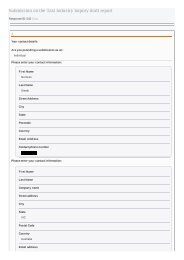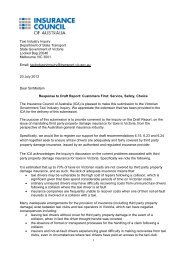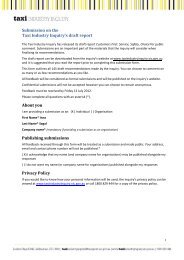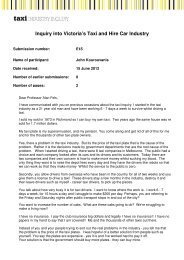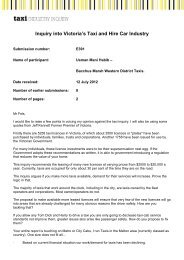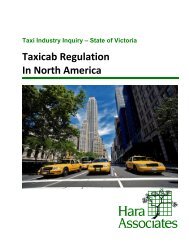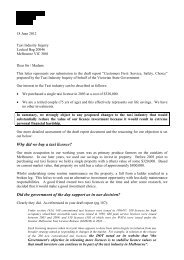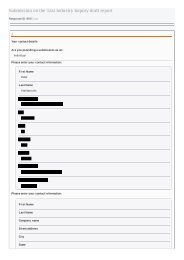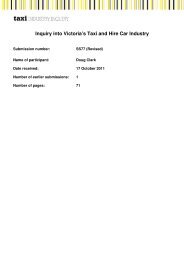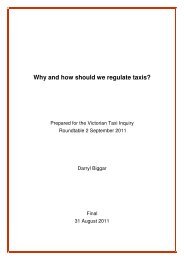Part D â Understanding and improving industry performance (PDF ...
Part D â Understanding and improving industry performance (PDF ...
Part D â Understanding and improving industry performance (PDF ...
Create successful ePaper yourself
Turn your PDF publications into a flip-book with our unique Google optimized e-Paper software.
To compete with Cabcharge, the newer entrants to<br />
the payment systems market have to differentiate<br />
themselves by offering rebates directly to operators<br />
<strong>and</strong>/or drivers. CabFare, Taxi LiveEpay <strong>and</strong> GM Cabs<br />
all provide rebates or commissions to operators<br />
<strong>and</strong>/or drivers who use their facilities. This can be<br />
up to a five per cent rebate on the surcharge. 21<br />
Some taxi operators have told the inquiry that this feature<br />
has become an important revenue stream to their business.<br />
However, one <strong>industry</strong> participant advised the inquiry that<br />
the economics of these rebates are ‘marginal’, representing<br />
only $1,000 to $1,200 of income per year (or approximately<br />
$14 per week) in the best case scenario (based on a two<br />
to four per cent rebate on $40,000 worth of electronically<br />
processed fares).<br />
The inquiry underst<strong>and</strong>s that payment processing<br />
system providers use the remaining surcharge revenue<br />
to pay for such things as investment in terminals, backend<br />
processing <strong>and</strong> merchant service fees to card<br />
schemes <strong>and</strong> acquiring banks. These are the resource<br />
costs associated with supplying the services. The<br />
other payments appear to simply be transfers between<br />
consumers <strong>and</strong> operators, drivers or networks. 22<br />
Third party providers also compete with Cabcharge<br />
through their payment arrangements with operators. All<br />
payments from Cabcharge are transferred to operators via<br />
the NSPs to which they are affiliated. This process enables<br />
the NSPs to deduct charges such as assignment fees <strong>and</strong><br />
affiliation fees from the incoming credit reimbursements<br />
before they reach the operator. The inquiry has heard<br />
from operators that this eventual reimbursement usually<br />
takes up to two weeks (but can take longer) <strong>and</strong> that the<br />
process is not transparent <strong>and</strong> is difficult to reconcile.<br />
Conversely, third party providers do not involve the NSP<br />
<strong>and</strong> transfer money directly to operators in a much more<br />
timely <strong>and</strong> accountable manner.<br />
Inquiry findings<br />
è The competitive practices that disburse the<br />
proceeds of the 10 per cent surcharge do not<br />
benefit consumers in any way. Rather, they<br />
simply serve to demonstrate that a 10 per cent<br />
surcharge far exceeds the resource costs of<br />
providing the payment service.<br />
è The inquiry considers the service fee levied on<br />
the procuring of electronic payments should<br />
be brought under regulation as part of taxi<br />
fares <strong>and</strong> set at a level that better reflects the<br />
resource costs of providing this service.<br />
What’s happening in other places?<br />
New York City<br />
In New York City, around 50 per cent of taxi trips<br />
are paid for electronically, either by credit cards or<br />
debit cards.<br />
Passengers do not pay a surcharge for using credit<br />
or debit facilities. Drivers are not permitted to charge<br />
more for credit or debit than for cash payments.<br />
Medallion owners are responsible for the technology<br />
in the taxi <strong>and</strong> are able to deduct up to five per cent<br />
of the fare box paid for electronically from drivers’<br />
payments. The credit/debit card fees for owners are<br />
around 3.5 to 4 per cent. These costs include fees for<br />
banks <strong>and</strong> vendors.<br />
The <strong>industry</strong> regulator, the Taxi <strong>and</strong> Limousine<br />
Commission, argues that there are significant<br />
benefits from using non-cash payments that accrue<br />
to both the <strong>industry</strong> <strong>and</strong> passenger.<br />
Research shows that acceptance of credit <strong>and</strong><br />
debit cards presents an opportunity for increased<br />
revenue – more trips <strong>and</strong> greater tips! Drivers will<br />
also benefit from increased safety. 23<br />
21 The Australian (8 October 2011), ‘Cabbies want cut of plastic fare fees’,<br />
www.theaustralian.com.au/national-affairs/cabbies-want-cut-of-plasticfare-fees/story-fn59niix-1226161614795,<br />
accessed 4 January 2012<br />
22 Given the highly competitive situation of operators, the inquiry would<br />
expect that these rebate payments to operators are competed away<br />
(likely to be reflected in higher assignment prices for licences): that<br />
is, operators with access to these additional revenue streams will be<br />
able to outbid other operators for licence assignments. Therefore,<br />
the ultimate beneficiaries of these payments are likely to be licence<br />
holders. Given the less competitive situation of networks, it seems more<br />
plausible that the networks benefit from fees received from Cabcharge<br />
23<br />
As discussed in section 12.3.2, even with the lessening<br />
of some barriers to competition – such as access to<br />
processing Cabcharge-br<strong>and</strong>ed cards <strong>and</strong> the removal<br />
of the MPTP-Cabcharge monopoly – the 10 per cent<br />
surcharge is likely to remain common practice. Market<br />
pressure for a reduction in the surcharge may only occur<br />
if <strong>and</strong> when taxi operators <strong>and</strong> networks effectively<br />
compete for consumers by lowering fares <strong>and</strong> the costs<br />
of associated payment methods. 24<br />
23 See www.nyc.gov/html/tlc/html/<strong>industry</strong>/taxi-cab_serv_enh.shtml,<br />
accessed 4 April 2012<br />
24 At present, customers have limited ability to know if a taxi fare will be<br />
discounted. For example, operators have only limited opportunity to<br />
let their customers know that their card processing fee is less than 10<br />
per cent. Given this, <strong>and</strong> the fact that fares are m<strong>and</strong>ated, there is little<br />
incentive for discounting on a wide scale<br />
<strong>Underst<strong>and</strong>ing</strong> <strong>industry</strong> <strong>performance</strong> CUSTOMERS FIRST 259




